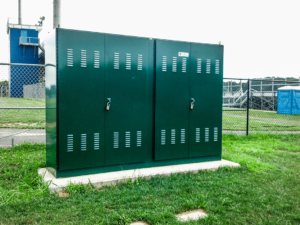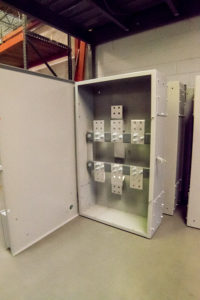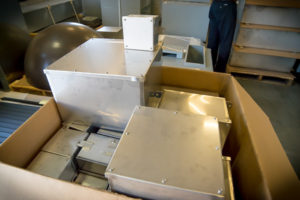About:
 Electrical Enclosures are a core safety features of a robust electrical system. They have a two-pronged purpose of not only protecting users from live parts of an electrical system but are also designed to protect electrical wiring and /or equipment from harsh environments, related to severe weather conditions or industrial hazards.
Electrical Enclosures are a core safety features of a robust electrical system. They have a two-pronged purpose of not only protecting users from live parts of an electrical system but are also designed to protect electrical wiring and /or equipment from harsh environments, related to severe weather conditions or industrial hazards.
Enclosures are box-shaped cabinets which carefully nestle electrical wiring and/or equipment. Materials used to make these enclosures can include either steel, stainless steel, aluminum or fiber-glass reinforced polyester. Sheet steel enclosures are the most widely used by industry. To reinforce the protective strength of the cabinet, a rigorous phosphate and powder paint process is followed. Phosphate coating serves to create a barrier  against corrosion while the powder coating creates the main protective barrier against several external elements. The powder which is electrostatically applied, has a mix of epoxy and polyesters which protect the cabinet from the adverse effects of chemicals, solvents, extreme weather as well as scratches.
against corrosion while the powder coating creates the main protective barrier against several external elements. The powder which is electrostatically applied, has a mix of epoxy and polyesters which protect the cabinet from the adverse effects of chemicals, solvents, extreme weather as well as scratches.
Types & Ratings:
Electrical enclosures can be classified along two dimensions, namely, their size as well as the level of protection they provide. In terms of size, enclosures can take the shape of relatively smaller junction boxes, larger wall-mount setups or still larger floor-mount or free-standing enclosures. The choice of size is dictated by location as as well as the size of the equipment / wiring that needs to be enclosed.
To provide a trusted safety rating for a particular enclosure, which is easily  identifiable, two standard setting bodies, namely, Underwriters Laboratories (UL) and National Electrical Manufacturers Association (NEMA) have developed a comprehensive enclosure rating scale. The scale is calibrated according to the harshness of external conditions that the equipment can endure, including dust, water or snow, oil or other forms of coolants. In order to get a particular certification for a product, the manufacturer is required to successfully test the product under the specified rating conditions. NEMA VS UL Comparison
identifiable, two standard setting bodies, namely, Underwriters Laboratories (UL) and National Electrical Manufacturers Association (NEMA) have developed a comprehensive enclosure rating scale. The scale is calibrated according to the harshness of external conditions that the equipment can endure, including dust, water or snow, oil or other forms of coolants. In order to get a particular certification for a product, the manufacturer is required to successfully test the product under the specified rating conditions. NEMA VS UL Comparison
NEMA ratings are the more popular and prevalent of the two rating systems, and when it comes to electrical enclosures the most common electrical enclosure rating is the NEMA Type 1, NEMA Type 3R and NEMA Type 4X. Enclosures of all three ratings provide adequate protection to personnel working near the enclosure. In terms of equipment protection, a NEMA Type 1 enclosure can be only used indoors and is the lowest on the protective scale providing protection from dirt and similar particulate matter. A NEMA Type 3R enclosure can be used either indoors or outdoors and provides protection from dirt, water (including rain, sleet and snow) and is expected to withstand the formation of ice on the enclosure body. The NEMA Type 4X enclosure is of a higher rating to the Type 3R; it incrementally provides greater corrosion protection as well as protection against hosed directed water.